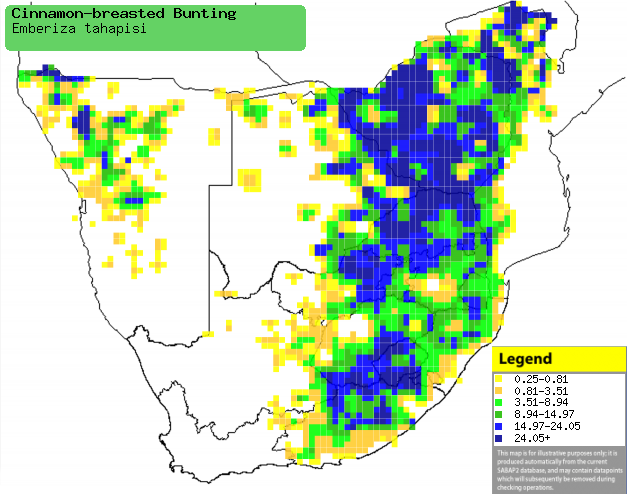|
Emberiza tahapisi
(Cinnamon-breasted bunting, Rock bunting)
Klipstreepkoppie [Afrikaans]; Undenjenje, Undenzeni
[Xhosa]; umDinasibula [Zulu]; ’Maborokoane [South Sotho]; Mvemvere [Shona];
berggors, zevenstrepen-gors [Dutch]; Bruant cannelle [French]; Bergammer,
Siebenstreifenammer [German]; Escrevedeira-das-pedras [Portuguese]
Life
> Eukaryotes >
Opisthokonta
> Metazoa (animals) >
Bilateria >
Deuterostomia > Chordata >
Craniata > Vertebrata (vertebrates) > Gnathostomata (jawed
vertebrates) > Teleostomi (teleost fish) > Osteichthyes (bony fish) > Class:
Sarcopterygii (lobe-finned
fish) > Stegocephalia (terrestrial
vertebrates) > Tetrapoda
(four-legged vertebrates) > Reptiliomorpha > Amniota >
Reptilia (reptiles) >
Romeriida > Diapsida > Archosauromorpha > Archosauria >
Dinosauria
(dinosaurs) > Saurischia > Theropoda (bipedal predatory dinosaurs) >
Coelurosauria > Maniraptora > Aves
(birds) >
Order: Passeriformes > Family: Fringillidae
Distribution and habitat
Occurs across much of sub-Saharan Africa, from Senegal to
Ethiopia through the DRC, Tanzania, Zambia, Angola and Malawi to southern
Africa. Here it is uncommon to locally very common in Zimbabwe extending into
western and northern Mozambique, the eastern half of South Africa, Lesotho,
Swaziland, eastern Botswana and north-western and central Namibia. It generally
prefers mountainsides, rocky ridges, dolerite and granite outcrops with
scattered bushes and trees, bare rocky clearings in woodland, eroded stony
slopes and gullies, dry watercourses and deserted borrow pits and quarries.
|
 |
|
Distribution of Cinnamon-breasted bunting in
southern Africa, based on statistical smoothing of the records from
first SA Bird Atlas Project (©
Animal Demography unit, University of
Cape Town; smoothing by Birgit Erni and Francesca Little). Colours range
from dark blue (most common) through to yellow (least common).
See here for the latest distribution
from the SABAP2. |
Movements and migrations
Largely resident, with some populations
(especially in Zimbabwe and north-eastern South Africa) undertaking
a northerly Winter migration from November-May.
Food
It mainly eats seeds and insects, mainly foraging on bare
ground among rocks, occasionally plucking food from grass and hawking termite
alates aerially. The following food items have been recorded
in its diet:
- Seeds
- grasses
- Aristida (bristle grasses)
- Melinis repens (Natal redtop)
- forbs
- Insects
Breeding
- Monogamous solitary nester, building a shallow cup of grass, rootlets and
fine twigs on a foundation of large twigs, neatly lined with fine grass and
rootlets. It is typically placed in a shallow depression in the ground at
the base of a grass tuft or rock, on an earthen bank, in a crevice in a
small rock face or among scattered rocks in a hollow.
- Egg-laying season is from October-June, peaking from January-April.
- It lays 2-4 eggs, which are incubated by both sexes for about 12-14
days.
- The chicks are fed by both parents on a diet of mostly seeds, leaving
the nester after approximately 14-16 days.
Threats
Not threatened.
References
-
Hockey PAR, Dean WRJ and Ryan PG 2005. Roberts
- Birds of southern Africa, VIIth ed. The Trustees of the John Voelcker
Bird Book Fund, Cape Town.
|
